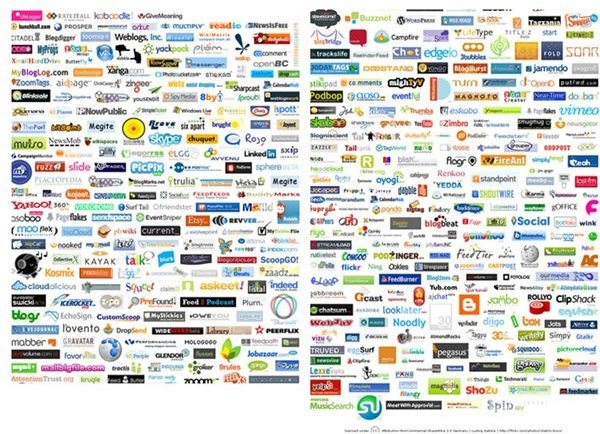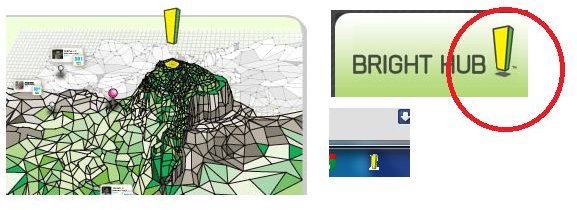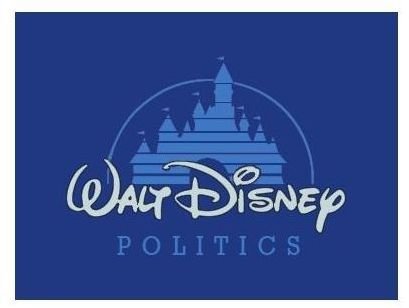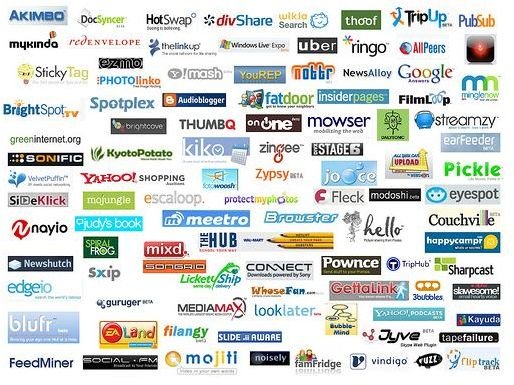DIscover How to Get a Copyright or Trademark for Your Logo & Why You'd Want To
According to USLegal.com, “A logotype, commonly referred to as a logo, is a graphical symbol created for an individual company or product. It is designed to communicate quickly, and to be a distinctive and easily recognizable symbol. Logos often include a special typeface or font used to spell out the company name or initials. They also tend to include specific colors and graphical shapes.”
Logos are symbols which, those who use them hope, are uniquely easy to recognize by the public.
web 2.0 logos by c_ on Flickr
A Little About Trademarks
Trademarks are a special form of intellectual property, because unlike copyright or patents, a registered trademark in continual use does not expire. In the United States, register with the U. S. Patent and Trademark Office to get a copyright or trademark for a logo.
Only when a trademark is registered does it have the right to use a legal symbol – a trademark indicator – which is put next to the trademark, ®. A trademark symbol, like the copyright symbol ©, is really a logo itself, in that it is a form of branding. Trademarks can be used without being registered, but this gives the user limited legal rights. The symbol ™ also indicates a trademark – but does not indicate whether the mark has been registered.
Branding

Because a logo is so identifiable, companies go to great lengths to have their logo associated with their brand or identity. It is a case where a picture – or wordmark – is worth far, far more than a thousand words. Because of the value of branding, the World Intellectual Property Organization (WIPO) protects logos under the categories of Trademarks or Copyright.
Logos can be trademarked, but usually not copyrighted, depending on their form. They fit under the definition of intellectual property. Trademarks refer specifically to an association of the logo with a product or brand. Copyrights are given to works of creative expression, and so it is possible that a design for a logo could be copyrighted.
Since a trademark has the ability to be retained indefinitely, if registered and kept in use, it makes more sense for a logo to be trademarked, since copyright has a definite term, even if the length seems to keep being extended.
image VW logo by jiazi on Flickr
Two well known logos are the Microsoft Windows colorful skewed blocks, and Apple’s apple with a bite missing. Every popular browser has a recognizable logo. Logos do change – usually incrementally.
Some logos are of the form known as wordmarks. A great example of that is the Coca Cola wordmark – in red, with flowing script, it is known

the world around. Another, as well known although not as old, is the Google wordmark displayed on the Google homepage.
When a word is trademarked, it must not be in general use as a category. This is the reason why Google, despite Larry Page himself using the word googled, attempts to keep googling from becoming a synonym for searching on the Internet. Language, however, changes. The verb google, or googled, entered dictionaries in 2006, and was named the word of the decade of 2000 – 2009.
<em>image Firefox logo by Andreia on Flickr</em>
Logo Creation

Many websites have logos as favicons – like the yellow exclamation point on the Bright Hub site. With the release

of IE9, those favicon logos can be attached to the taskbar in the Windows operating system, and many more people have become interested in having their own logo.
Some people create their own logos, and others pay to have a logo designed for them. That cost can vary greatly. Graphical tools available on computers have made the design of logos far easier than in the past, although many classic logos were designed without the help of specialized programs or special fonts.
If you are interested in creating a logo yourself, Bright Hub has a review of five great logo creation applications, where you can experiment to your heart’s content without paying for designers. Or put together an idea, and then have someone refine it.
<em>image web 2.0 logos by mmmonica on Flickr</em>
screenshots Bright Hub logo / favicon in taskbar by writer
Getting Your Logo Registered
So, getting a copyright or trademark for a logo must begin with a unique symbol or design for your product, brand or site. Then use the free access to the databases for trademarks at the US Patent and Trademark site to make sure that either no one has registered your logo, or that it is marked dead, if it is in their files. At that point you pay a fee per class of goods/service to register the trademark. This can be done online, and is less expensive that way. During the search, it is possible to find that the trademark you are trying to research and register has been used - but is listed as dead - which means that a registration is not currently in effect for the trademark.
Trademarks in most countries are generally registered for ten years at a time, although the time period is longer in some countries. A dead trademark can be registered again by someone else.

And finally, there is the question of trademark satire. While trademarks are protected as intellectual property, satire is a valid form of fair use. Sometimes, the logo is so recognizable that even though it has been made a part of a satire, the brand still receives a benefit from the recognition. However, Walt Disney rising over politics is a satirical statement.
Depending on how it was spoofed, it may not hurt the original brand at all. Consider this: the idea of Google’s wordmark. Use Google’s colors, invert the g, and peer at the Internet through those colorful glasses. Of course, since Google spoofs its own logo regularly, they obviously take its sanctity with a grain of salt - or an appreciation for humor.

<em>image Walt Disney logo satire by sbwoodsie on Flickr</em>
Google spoof logo by author
References
U. S. Patent and Trademark Office
https://www.uspto.gov/trademarks/basics/BasicFacts_with_correct_links.pdf
https://www.inta.org/TrademarkBasics/FactSheets/Pages/TrademarkRegistrationFactSheet.aspx
